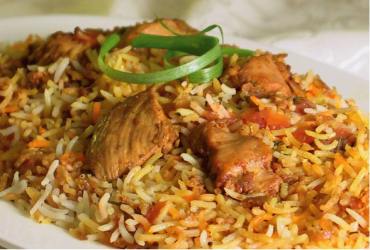Biryani

Biryani is a rice-based dish made with spices, rice (usually basmati) and
chicken, mutton, fish, eggs, or vegetables.
The name is derived from the Persian word beryā(n) which means "fried" or
"roasted". It was originated in Turkey or Persia and brought to India by
Muslim travellers and merchants and Mughal. It was one of the most famous
dish in the kitchen of the Mughal Emperors. It is very popular in South Asia
and is a key element of the South Asian cuisine. Hyderabad, Malabar,
Delhi/Agra, Dhaka, Kashmir, Kolkata, Lucknow and Lahore, are the main
centres of biryani cuisine. A typical biryani meal provides 500 Cal of
energy.
Ingredients
The spices and condiments used in biryani may include, but are not limited
to, ghee (clarified butter), nutmeg, mace, pepper, cloves, cardamom,
cinnamon, bay leaves, coriander, mint leaves, ginger, onions, and garlic.
The premium varieties include saffron. For a non-vegetarian biryani, the
main ingredient that accompanies the spices is the meat—beef, chicken, goat,
lamb, fish or prawn. The dish may be served with dahi chutney or Raita,
korma, curry, a sour dish of auberine (brinjal), boiled egg and salad.
The difference between biryani and pullao is that while pullao may be made
by cooking the items together, biryani denotes a dish where the rice (plain
or fried) is cooked separately from the thick sauce (a greatly reduced curry
of meat or vegetables). The curry and the rice are then brought together and
layered, resulting in a dish of the contrasting flavours of flavoured rice
(which is cooked separate with spices) and intensely flavoured sauce and
meat or vegetables.
This separation is partly of necessity: the proportion of meat/vegetables to
the rice is high enough to make biryani a one-dish meal, and the cooking
time of each of the main ingredients is significantly different from each
other. In a properly made biryani, the final dish is dry or minimally moist,
with the individual rice grains separate, as opposed to a risotto, where the
rice is of a creamy consistency.
However, many biryani recipes call for the rice to be cooked for
three-quarters of the usual time, followed by layering with the
meat/vegetable base, and then a final slow-steaming until fully done: this
approach allows the flavours to blend somewhat.
Malaysia and Singapore Styles
Biryani dishes were introduced to Malaysia and Singapore by the Indian
Muslim as well as the Arab diaspora. Biryani Bukhara is a local adaptation
of Buhari Biryani, originating from Tamil Nadu, India. Another biryani
variation called Nasi Beriani Gam is an adaptation of the Indian Dum Biryani.
Nasi Minyak, a dish commonly served at Malay weddings in Malaysia, Singapore
and Sumatra, is also sometimes referred to as Nasi Beriani. However, this is
actually a variation of the Indian ghee rice. Just as with the Indian
version, the rice in Nasi Minyak is cooked separately from the meat.
As such, Nasi Minyak is generally not considered a Biryani by the Indian
diasporas in Malaysia or Singapore. However, as with Biryani, Nasi Minyak is
usually served with acar as condiment. Malaysian/Singaporean Nasi Minyak is
typically served with chicken or beef Rendang, a decidedly Malay take on dry
spicy Indian meat curries.
Sources: Wikipedia
undo ...back